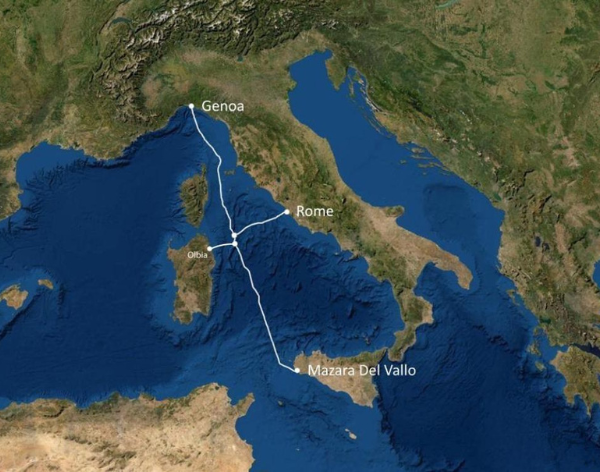In the Tyrrhenian Sea to the west of mainland Italy, a fresh piece of the global communications landscape has been forming deep beneath the waves. Now, having newly entered into service, this subsea cable offers an attractive alternative to traditional options at a key strategic point in the centre of the Mediterranean.
This is the Unitirreno cable of Italian telecoms, cloud and IoT operator Unidata, funded by Italian investment firm Azimut. It extends for 1,128km, running from Mazara del Vallo in northwestern Sicily to Genoa on the northwestern mainland, with an eastern branch to Rome and a western branch to Olbia near the northern tip of the island of Sardinia.
The cable, which has 24 pairs of optical fibres and a design capacity of 624Tbps, provides a secure, lowlatency route for data transit between Europe, Africa and the Middle East at a key strategic point in the middle of the Mediterranean, while considerably reducing round-trip time compared with terrestrial networks. “The latency on the cable between Mazara del Vallo and Genoa is less than half that of the typical level via domestic terrestrial backbone networks,” says Renato Brunetti, CEO of Unitirreno.
Big prospects
The Unitirreno cable will also provide access to carrier-neutral data centres in Italy, including upcoming facilities planned in the emerging connectivity hub of Rome by different players.
“There’s a new wave of investment in data centres in Rome,” says Brunetti. “Data centres are moving from the north of Europe further south, and we think Rome will be a new place where they develop in Italy. Connecting to data centres there will also provide better performance for users in North Africa and the Middle East.”
Furthermore, Italy’s capital city offers much more available space and power at present than the more crowded hub of Milan. At the same time, the network’s landing point in Genoa is still in relatively close proximity to the country’s centre of activity, at less than 150km south of Milan.
Brunetti adds that the cable helps position the country as a strategic digital hub, while offering an alternative to landing at traditional hubs like Marseille in France. “In Mazara del Vallo, we can also host some edge projects that will be very important for North Africa and will minimise latency,” says Brunetti.
Sicily at the centre
The landing point in Sicily, meanwhile, harnesses the island’s aspiration to put itself at the centre of Italy’s digital transition, lying in a strategic location to connect onwards to the country’s key hubs and cities. Sicily is also seeking to innovate and enable the infrastructure to attract investments, while carrying out initiatives to boost citizens’ digital skills and digitalise public administration. In addition, it has launched programmes to strengthen adoption of the cloud and business information modelling in public works.
Together, these factors promise to further enrich the Mediterranean as a centre of growth for digital communications, adding much-needed secure pathways at a time of surging demand for capacity and making the area even more attractive as a centre for connectivity. “There’s a lot of need for infrastructure at the moment across different regions because AI is powerhungry in terms of both computing and electricity, as well as storage,” says Brunetti.
The right partners
At the same time, Brunetti concedes that subsea cable projects are complex and expensive to set up, with having the right partnerships being one crucial factor in making them resource- and cost-effective. He cites the securing of sound investment partners, such as Italy’s Azimut in the case of Uniterreno, as well as agreements like Unidata’s deal with Sparkle to use the operator’s landing station in Genoa.
That kind of deal gives the cable system strong access to key interconnection facilities in Europe. “We have a good collaboration with Sparkle in Genoa and hope this continues into the future,” says Brunetti.
And he believes that Unitirreno will provide a springboard for digital growth. “We think this cable is important as part of the digital future of both Italy and Europe,” says Brunetti. “It provides good opportunities as a bridge between each side of the Mediterranean and between continents.”







